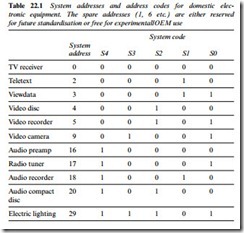IR RECEIVER AND DECODER
The infra-red RC signals are detected by a photodiode whose stand- ing current is modulated by the incoming light pulses. A sharply tuned
filter immediately follows the diode to reject noise and out-of- band (38 kHz) components. Next comes a preamplifier whose main characteristic is its very wide a.g.c. range of about 140 dB, required to cope with the large variation of IR signal level which may be encountered.
In simple receivers the coded message is simply converted into parallel data and decoded to give a series of output lines, each of which change state when the corresponding button of the remote handset is pressed. Such outputs are used for channel selection; for off- or standby-switching via a solenoid on the mains switch or a ‘pull-down’ line to the PSU; and for control of such analogue functions as brightness, colour and volume, where the appropriate control line feeds an interface IC whose PWM output is varied in respect of duty-cycle for as long as the command is received, and held constant thereafter. Integration of this PWM pulse train in an RC circuit renders a d.c. control voltage for application to the voltage-controlled attenuators (VCAs) within the signal-processing chips described in earlier chapters, e.g. colour decoder.
